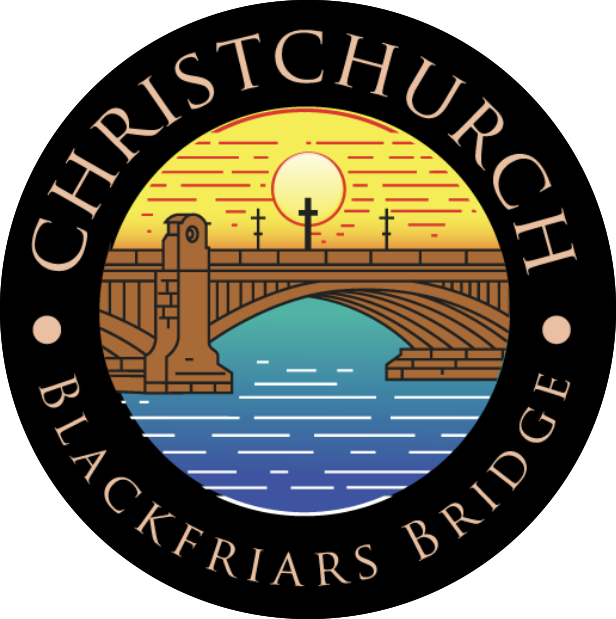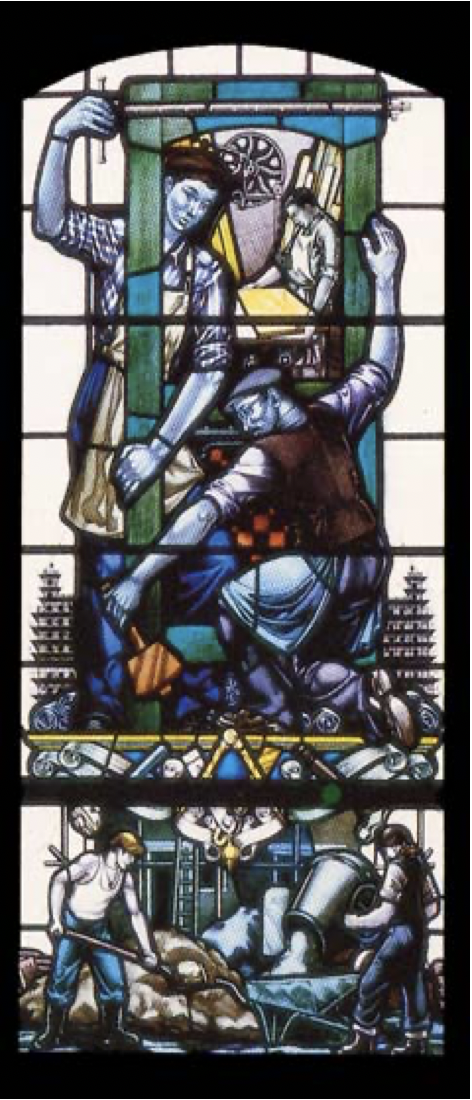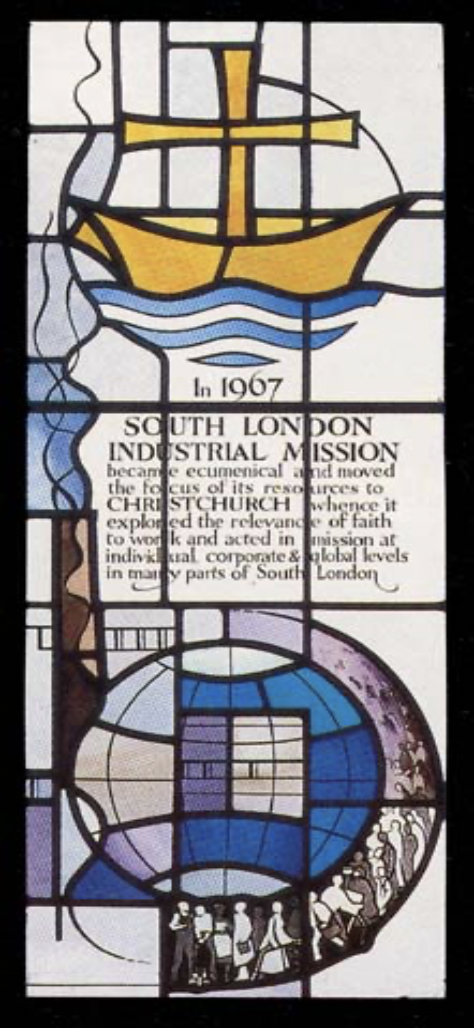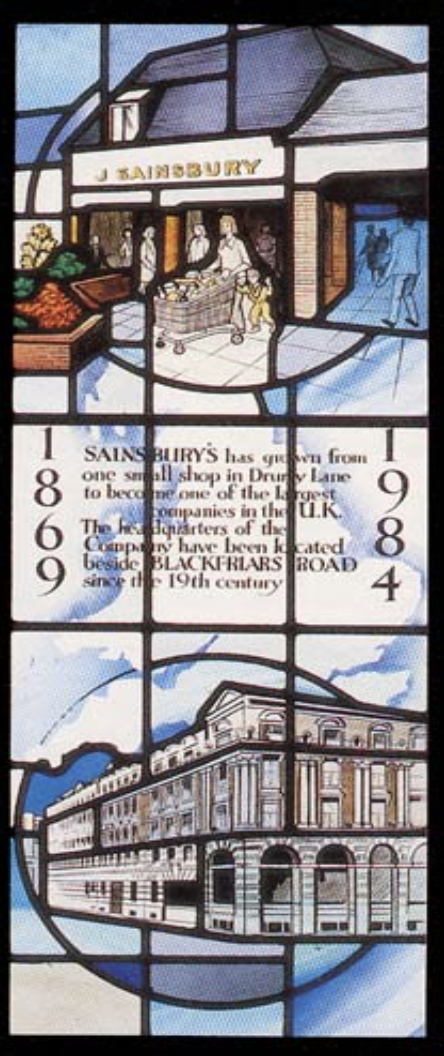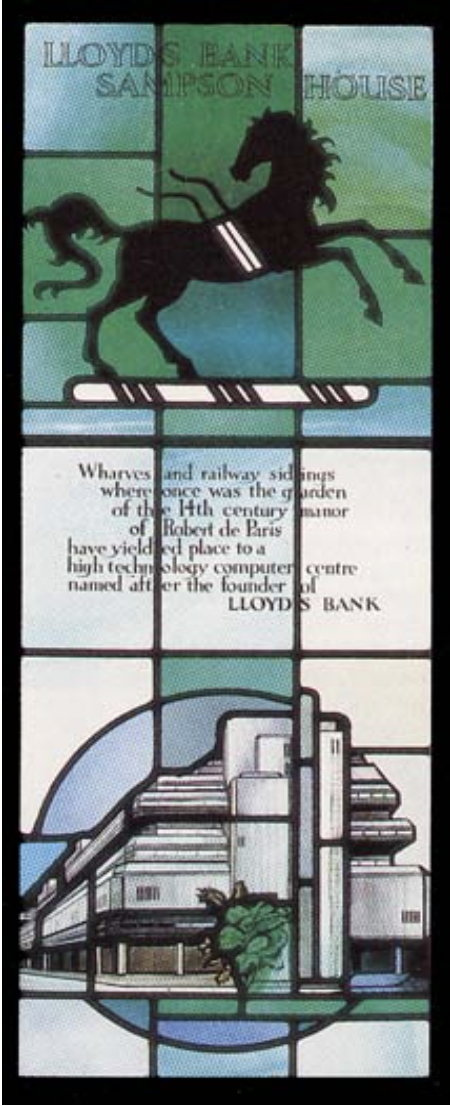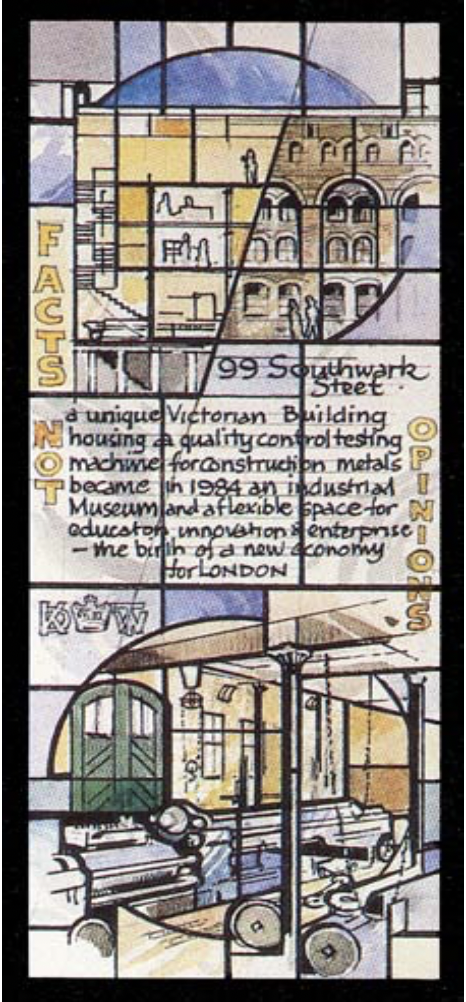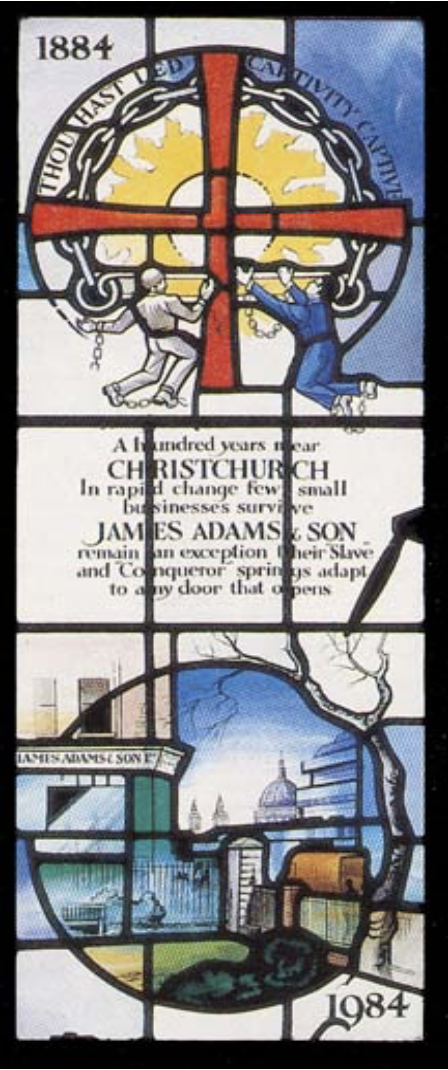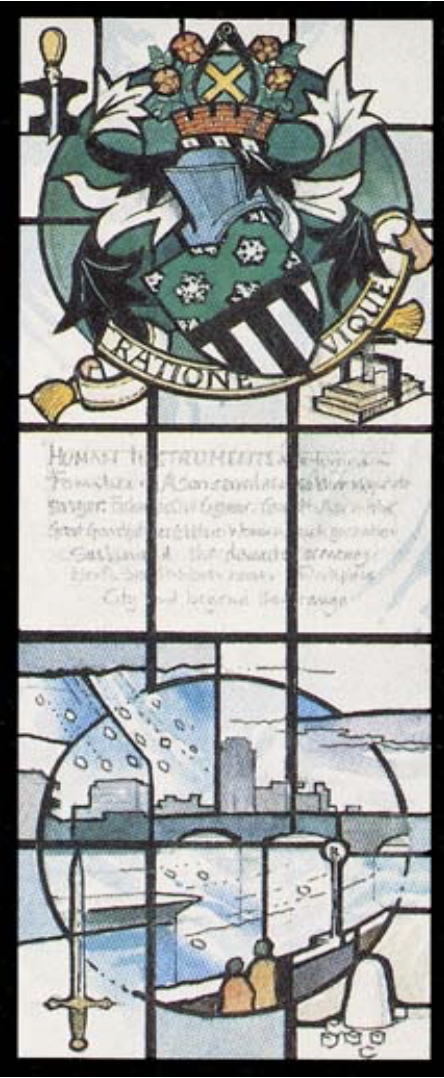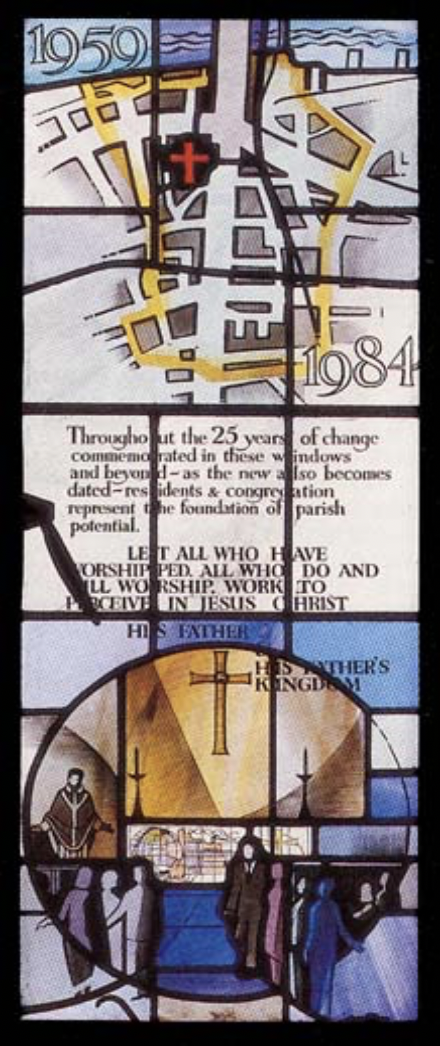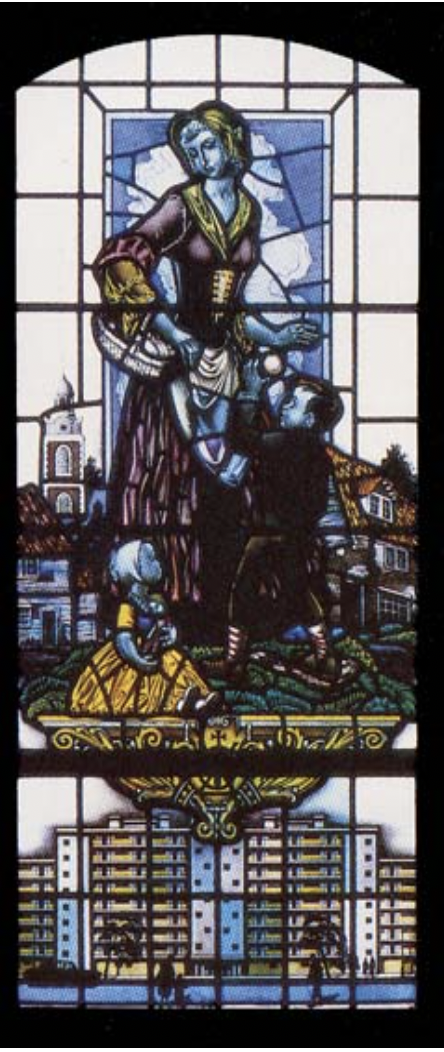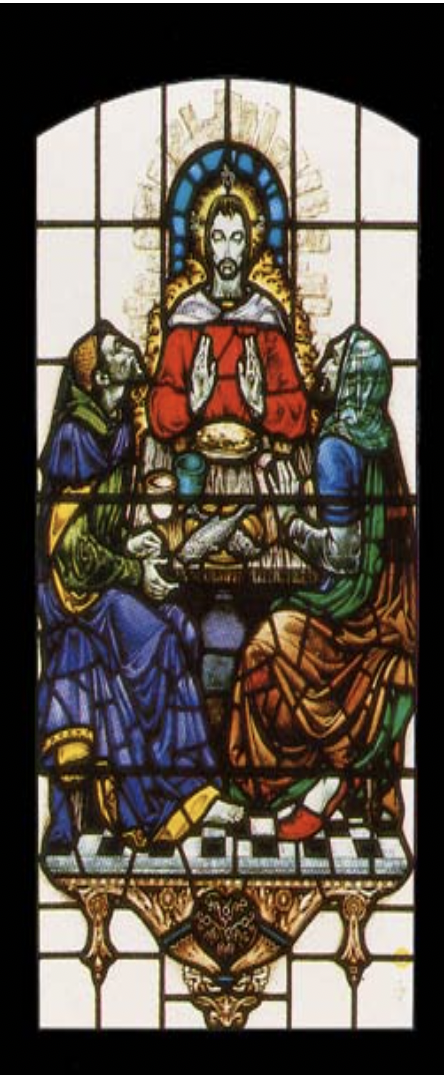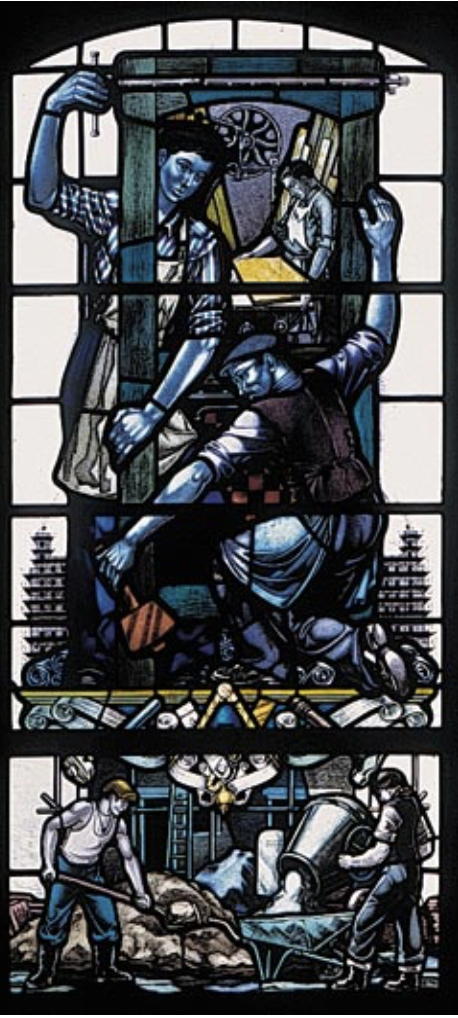CRAFTSMEN AND LABOURERS IN CONSTRUCTION
This window and the one below were made in 1959. They typify construction on the SouthBank and a river providing a channel of trade for skins, wood pulp food and other resources for local factory and workshop. If raw materials came from far afield, skills, sites, traditions and trade loyalties were local contributions. Those who worked and managed traveled relatively short distances. Few people anticipated the rate and range of changes just ahead. The next twelve windows tell something of the changes that had come in only 25 more years. In these windows, old and new, a story unfolds that challenges us all to expect the unexpected and to find therein ways of retaining the rich strains of a mixed but inclusive community for residents and working population side by side. It is not an easy task. Every one has a contribution we should generously expect and evoke. Some contributions glow, some seem to glower, others are still hidden or even suppressed. How are we to nurture a community today in which everyone contributes in relation to their gifts? The best of traditions and of practice in the Christian church reveal good news we call the Gospel to aid us in this task of being fully human under God. Is this good news expounded and explored in ways that make sense of our society, of its social and its economic patterns? The windows now shown are symbolic of an attempt made out of Christ Church and the John Marshall Hall, to expound and explore.
LIGHTERMEN AND CITY VISTAS
Strong and colourful men once plied the river between ocean-going cargo boats and Thames wharves. They are no more. Dominant and inspiring was St. Paul's Cathedral, giant symbol in a low-rising city. It is now almost dwarfed. The window shows a view that is gone. The 1959 windows indicate relatively slow change, they were sponsored by Marshall's Charity and illustrate general trades, the occupations of local residents. The 1984/5 windows are each sponsored by a specific institution. In the 1950s and 60s the throbbing business of the river ebbed and pleasure boats or tourist-craft became the major water-borne activity. But the new economic enterprises on the river bank and in the now towering city represent rapid and accelerating change, which can both perplex and inspire. Therein lies a challenge to the living church and to all who aspire to faith in the love of God. Can we see in Jesus the Christ a model of our human contribution to his Father's kingdom in our city? The 1984/5 windows illuminate something of the change and of its challenge to the interpretation of faith. Taking up the theme in these windows on the world of work, how do we human instruments' use the 'resources of nature' to 'give worth to God through responsible service to our society'?
CHRIST CHURCH 1
A small congregation sponsored the first (and the last) window of the 1984/5 series. It illustrates the third building of Christ Church, set in the context of riverside South London and both the Diocese and Borough of Southwark. In that area clerical and lay ministry is to be exercised and witness made. It invites local enterprises to recognise and identify their opportunities to use the gifts of nature and human skills in giving worth to God through responsible employment and every form of work. Donations for this window came from the living in respect for friends and relatives who had died. Other people generously supported the adventure in symbolism and interpretation because of a connection with one or other of the explorations of faith encouraged at Christ Church and the South London Industrial Mission. All the names are recorded in a book kept close to the windows. Let one name alone be mentioned here, Daisy Bryant. She served the church and centre and all who came here for more than 45 years, keeping that faithful service up until she was 95. But behind every name in the book lies another important story of why there is a particular association with the Christ Church buildings that helped them all to stir their minds to a greater understanding and practice of a faith that could make us all more human under God and towards each other.
SOUTH LONDON INDUSTRIAL MISSION
Getting faith to work is the aim of the South London Industrial Mission. It is a mission by and to people in relation to work and its setting. From Christ Church, 10 chaplains of all denominations go out into factories, offices, business schools and other institutions. They seek to listen and learn. They want to stand by people at their work and understand the pressures and potential with which humanity wrestles in specific places. When trust in their intention is evoked chaplains can support people in bolder interpretation and practice of their faith. SLIM made Christ Church its focus in 1967 when parish and mission were combined through the appointment of a Rector/Senior Chaplain to put into force a unique ecumenical constitution. In 1985 the South London wide network of men and women endeavouring to be socially faithful in economic and political activity is numerous, diverse and facing many tough issues. This ministry also encourages varied uses of the John Marshall Hall and its ancillary rooms; making Christ Church a visible example of the church in engagement with society. All this is symbolised in the window. Practical people, all round the world, work through, or in relation to; institutions of many kinds to create one inhabited earth: a home of justice and peace for us all. The same theme is seen in the altar frontal created by previously unemployed young people and in the Christ Church 2 window.
J. SAINSBURY PLC
Sainsbury's is a family business; now also embodying employee and public share-holding. It was founded in 1869 by a young couple in Drury Lane. On this foundation four generations have built. In 1985 50,000 people were employed. This window symbolises one hundred and fifteen years of growth from a small dairy to the modern multiple chain of super- and hyper-markets and a complex organisation supplying and servicing them. Each new generation of family and each member of the enterprise, as they have come into business, has had to meet the changing market needs and commercial conditions of the time; many made changes that transformed the style and structure of the business. The story is of constant adaptation; the reshaping of the company's methods of selling, training and management. Although the changes were notable, the basic principles the founder established a hundred years ago remained largely intact. Matters of scale, consumer choice, the introduction of new technologies, becoming a public company, encouraging staff consultation and share distribution, often tested the business and human acumen of managers and staff as the service they provided reached out across England. The window symbolises how J Sainsbury plc represents diligent and responsive service in high quality provision of food. With its head-quarters in the parish, it seeks to serve the nation.
LLOYDS BANK
Change may well be the only permanent feature of life, in little matters and in great. Typifying the latter is the change related to the giant edifice in Hopton Street between the river and Southwark Street. On the site of old railway warehouses demolition, then digging deep foundations in anticipation of a banking network's evolving computer needs, made place for Lloyds Bank Operations Centre. This first disturbed the scene and then was steadily accepted by many as a significant symbol of the requirements of new technology which influenced everyone and was itself subject to rapid change, first in magnification of scale and then in miniaturisation. We can all share in grappling with the many difficult questions and decisions about the use that is made of money, technology, accounting, auditing and banking in its many forms, so that in everyday economic matters opportunities for wise action are heightened and dangers of deep indignity averted. The Christian faith has relevance to the £ in your pocket, the micro-computer on your desk and every thing from matters pertaining to the sustenance of individuals to the wealth of nations. The quantum leap in Information Technology was of major new significance in the 1980s as the advent of this bulky, yet strangely intriguing building testifies
SEA CONTAINERS
The riverside has seen many changes. Marshes were succeeded by tiny houses, and by docks and wharves plied by lightermen. Then followed pallet and container carried trade. Most of the remaining houses and small businesses gave way to consortia and giant enterprises. Among these the sponsors of this window, Sea Containers came to the parish in the 1980s with related development. The change was typical of the riverside. All windows reveal the marked increase in the scale of economic activity, when local unemployment is increasing steeply. National and international outreach is now monitored here. Global business infiltrates the locality. All who work or reside beside the river at Blackfriars are bound together - and yet have little in common in our varied experiences and responsibilities. The placing of such a window in a parish church suggests a remnant of hope that through new symbols people may look again to a faith that makes us sensitively human in the midst of baffling complexity. Look around for symbols. From Upper Ground to Lower Marsh, from Kings Reach along to Nelson Square, there are things on every hand reminding us of the responsibility we 'human instruments' bear for moulding the 'gifts of nature' into a socially exciting economy; giving space and creative opportunity to every one. Trade is made efficient by use of containers: the human spirit must not be contained but nurtured to mature and shared responsibility.
KIRKALDY EXPERIMENTAL WORKS
Take any one business address. Behind the facade will lie surprising activity. Consider 99 Southwark Street depicted here. In this unique Victorian building is found the quality control machine for metals used in construction, which made possible the safety of many elements of the country's infrastructure. After the Tay Bridge disaster in 1879 this machine tested the material with which it was renewed. Chelsea Bridge is evidence of its testing. In 1984 the Experimental Works became a museum of engineering; and much more, a flexible space for innovative enterprise. The window symbolises the birth of new aspects of the social economy of London. On foundations of sound infrastructure, including roads and bridges, our society can and does devise new enterprise that provides opportunity for those who in tough economic conditions lose, or, as for many young people, have not found, jobs. Urban Economic Development (URBED) and the Industrial Preservation Trust are interesting co-operators behind the facade of No 99. The church affirms in this window that on the foundations of earlier endeavour, new hope and enterprise are born; within which there are fresh opportunities to harness the forces of nature for the benefit of humankind and maintain a reverence for the earth.
TRADE UNIONS AT BLACKFRIARS
Hope for a strong, just and democratic economy should he an aspiration of the churches. Such hope is a prophetic strand of the Old and New Testaments, which influenced the early statements of purpose among the trade unions too. The church displaying this window is at the heart of a busy industrial centre and offers facilities to 12 Trade Union branches. Whether renting, letting, hosting or using occasionally, all users of this centre can slowly develop the shared wish to search for what the World Council of Churches called in the 1980s 'a just, participatory and sustainable society'. Ministry, administration, management and meeting are all activities that can enhance the search for communities from which everyone derives benefit. It is important that Trade Unions add their design to the symbolism of these windows. As the print unions were hosted in Chapels in their early years, so it is appropriate that this inter- church centre should re-enliven and widen the tradition. Moreover, out from this centre go many encouraged people to pursue the implications of a faith in God made manifest in human form. Unions, Management and the Church would be wise to retain and make creative the tension between requiring rights and fulfilling duties. All others would be wise to do the same.
INSTITUTIONS AND NEW LIFE
When we 'human instruments' handle the 'gifts of nature' for economic use it is usually within the structure of institutions. This window adopts the thought of Jubilee - that is, of thankful celebration and hopeful renewal. It suggests that natural creativity has been thought to be vested in the female and contrived creativity in the male. It is now apparent that both aspects of creativity exist in each and, par excellence, between them both. Every institution, if it is to contribute 'responsible service to society', must find new and comprehensive life continually within itself and frequently by breaking out. The upper symbol of the window is the logo of the Anglican Diocesan Jubilee in 1980. It is useful to look again at the vision, hope and good intentions that emerge in anniversaries, annual reports, memoranda and other records of our progress, to see if we do pursue our promises and aspirations. If audit is appropriate to funds, is it not also appropriate to faith?
JAMES ADAMS & SONS
The name of this firm doesn't spring rapidly to mind for many people, but it is a significant company... Why? It persists... when small businesses have succumbed. It produces... the sort of things we easily take for granted, springs for doors, manufactured with pride in their quality. It employs responsibly... winning an un-coerced, not bribed loyalty. It is local in positive senses... in an area where national and international giants increasingly predominate and blur unwittingly the useful boundaries of identifiable, well proportioned community. Out of this company came the idea for this series of windows on the world of work. Its members recognized that 100 years of service was worth commemorating and that a symbol set in the neighboring parish church could hold a happy tension between justifiable pride in both profit and survival and a commitment to measure service by the kind of humanity, business integrity and contribution to the community that is affirmed by the Christian faith.
The window draws a bold parallel between the well sprung door that opens up opportunities and access for its users and the power of the love of God, manifest in Jesus, to open up our human condition to new possibilities.
SNOW IN SOUTHWARK
'Human instruments' is a phrase in the theme of these windows. They are forged in families; and the Snows are a Southwark family. The window spans four generations. A Snow at work in the 1980s served as soldier, magistrate and surveyor. His father was the civil engineer to whose inspiration we owe the Unilever and UAC International buildings astride the Thames at Blackfriars. The grandfather was, not untypical for this area, in 'the print'. The great-grandfather cobbled shoes. Note in this window the emphasis on male jobs. It marks an era in which new recognition was arising of those on whom everyone relied heavily but barely acknowledged in their contribution. A place is perceived for those who sustained the domestic economy from which all other rises. It indicates a shift in roles gathering momentum at this time among men and women. Like shifts were occurring for ethnic minorities, for the disabled and others previously ignored or even exploited. As with all 'human instruments', the people of this family are both typical and exceptional. They provide a window which records their own history and also typifies the history of many with local roots and expanding influence. Symbolised here is the importance of boundaries within which people can be nurtured and mature; so that they can then have confidence to reach into other spheres.
BLACKFRIARS SETTLEMENT
The Womens University Settlement was established in 1887 by women from Girton, Newnham, Sommerville and Royal Holloway Colleges to relieve poverty in North Southwark by education and self-help. Blackfriars Settlement, as it became in 1961, continued to provide a range of services for the community, including clubs for young, old and blind; advice and information on welfare rights, housing and employment issues; literacy and numeracy classes for adults; a large range of activities for young people; support for community groups; a community photography project; housing for local homeless young people; and a work centre for mentally ill and physically handicapped people. The Settlement window symbolises its roots in the community as depicted by the main old building in Nelson Square and the concern for people: around the door that, if not literally, attempts always to be open to the needs of local people. The Church affirms and Christ Church supports these activities. The window is dedicated to all the community served by the Settlement and all those, past, present and future who have served the community through the Settlement. In establishing the window, paid for entirely by individual subscription, particular honour was paid to three outstanding women who devoted large parts of their lives to this community and who were widely loved and respected. They are Mary Pearson, Aida Tennant and Norah Hindley.
CHRIST CHURCH 2
10 enterprises responded to the invitation the congregation of Christ Church issued in the locality. Here in the final window the thrust of the adventure is symbolised. The edges of the parish are blurred, reminding us that every boundary we set around ourselves must be permeated that we may take account of the wider context in which our lives are set and our work undertaken. Only if we use boundaries for their limited purposes and also reach beyond, will we understand how giving worth to God enables us to become more human. Ultimately 'none of us can be fully human until all are human'. The suggestion is made that all who rejoice in worship or struggle to give worth, must recognize that Jesus the Christ pointed not to himself, but to his Father and his Father's kingdom.
'If God does not have a want for His world, then who does?' said Bishop Tutu, the South African winner of the Nobel Peace Prize in 1984. Our faith in God made manifest on earth sends us into the social, economic and political arena to replace dominion by service and coercion by co-operation. It challenges us to seek mutuality and equivalence between, women and men, servers and served, and people and nature, in all forms of work. These windows on the world of work symbolize the call to use the gifts of nature with human skills to give worth to God through responsible service to society.
MOTHER AND CHILDREN OF A BYEGONE AGE
The tower of the second Christ Church (1730-1941) rises above fishermen's wooden huts that stood until after the Second World War. The mother and children represented local residential community and the unacknowledged domestic economy, in contrast to the largely stereotyped patterns of unchanging roles for men and women in the other 1959 windows. Some of their descendants still live in the flats of Nelson Square, depicted in the lower half. Others have spread to outer parts of London or beyond. Newcomers to the parish now are often from afar: some to put down roots, others to move on as trade, profession or redundancy determines. The creation of aspects of community in an ever changing social mix is a skill our faith should help us to develop. Thus Christ Church and the John Marshall Hall accommodate many ways of meeting - in worship, in Tenants' Associations, in Union branches, in celebrations, in conferences and Quiet Days - to promote the community of rich diversity which is now possible, but only half-heartedly approached. The symbols of this church building are a reminder to users that we should all regularly renew our contributions to the restoration of community; beginning where we are.
SANCTUARY WINDOWS
The sanctuary windows in Christ Church put Baptism and Holy Communion at the heart of our worship. They are both significant for daily life; the first reminding us of our membership of the one mighty human family; the second calling us to share at the one table of that family in meals of peace and justice.
PRINTING
From first printing press, through the great rolling processes of the lower window, and on to high tech computer aided word and image making, the IT revolution sped on. Each change affected jobs, buildings and prospects in the area; and attitudes far beyond. Print and press were the a dominant industry in the environs of Blackfriars Bridge for two hundred years and then, within a decade, were gone, leaving the sheet glass tower of the Express building as the present and last monument to that ever alert, trend capturing, trend setting world of instant news, scoop and hype. Part of the exploration of faith that these windows represent lies in trying through every change to discern where intrinsic values lie.
BUILDING
Units of craftsmen labouring in small teams have a long history in the area, but the new symbol of change and seeming prosperity lies in heavily staffed high rise blocks and far reaching towers. Building skills are streamlined in specialisation and in huge construction projects. Tasks and fashioning once begun and ended on small sites. Then they were replaced by pre-construction far away with ponderous transport movements about each huge newly transforming site. Time pressures exact their penalties for falling behind tight and profit centred schedules. Under such pressures stress on structure and on persons mount. Ever greater social sensitivities are needed to invest always in people as well as in glorious and often awe-inspiring prospects of change.
ENGINEERING
Relatively recent skills of engineering saw many advances under the railway arches and in the small factories of the parish as the years rolled by. Then technology's steady advance became leaps of innovation; but still the skills of individuals were necessary for the finished product to be of a quality and relevance for ever-changing times. The information technology emerging so rapidly in the second half of the twentieth century hugely enhanced productive capacity, required higher mobility in job seeking, demanded frequent retraining and raised the potential for misuse in overproduction and in sophisticated weaponry. Choice is exciting and stimulates further invention, but also requires constant vigilance if justice, participation and sustainability are to remain benchmarks of the responsible stewardship of our immense resources fashioned for human use.
POWER GENERATION
The rapidity of twentieth century change is marked in this window. The majesty of St. Paul's, built in times of candlepower and oil lamps, still dominates the city scene to retain perspective and the dignity of other times. But electric power now reaches every corner of the country in lines of treelike pylons stretching across the landscape. Bankside Power Station, was a vital source of generation of such power for London, but the life-span of this remarkable edifice, (twin to Gilbert Scott's Liverpool Cathedral ) was but twenty-one years, before technical know- how moved electric power generation to other more economic sites and left a range of new site possibilities, making way for the proclaimed Tate Modern Museum to open there in 2000, following the Coin St. developments, the Globe Theatre, the Greater London Authority headquarters and the footbridge to St Paul's. All these pioneered remarkable new activities along the riverside, spanning the millennium years of expectation. Power generation is resonant with implications for those who take faith in the economy seriously.
BAKING
In the early days of the J Sainsbury move from Drury Lane to Stamford Street their own bakery was built nearby. Though the upper window shows the oven of an even earlier time, the lower section shows steam ovens; hinting therein at the mass output required by the developing supermarkets and the rising standards of taste evoked in the new consumer age. One of the earliest graduates of the Southwark Ordination Course, which shared this building for 20 years in the 70's and 80's, was a baker and worker-priest. Bread is so basic in daily life that this window stands in the imagination as an everyday link with the purpose of this building and the mission of its congregation - a centre of worship and of exploration in faithfulness of the purpose of our daily life and of our work for the common good.
